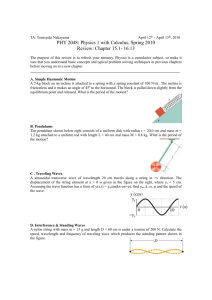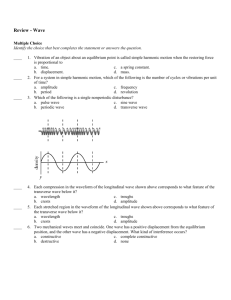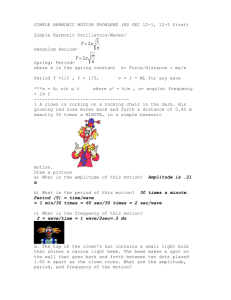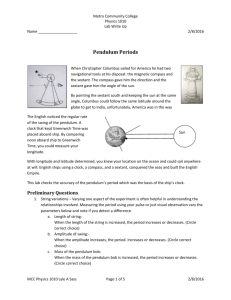Physics 111D - Rose
advertisement
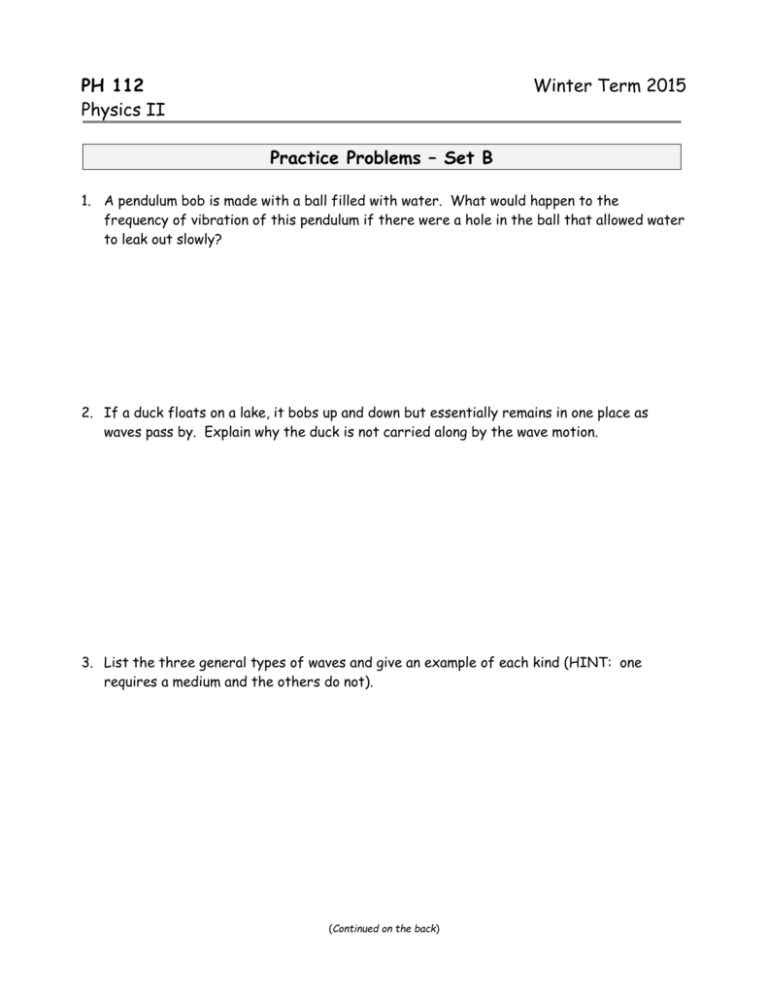
PH 112 Physics II Winter Term 2015 Practice Problems – Set B 1. A pendulum bob is made with a ball filled with water. What would happen to the frequency of vibration of this pendulum if there were a hole in the ball that allowed water to leak out slowly? 2. If a duck floats on a lake, it bobs up and down but essentially remains in one place as waves pass by. Explain why the duck is not carried along by the wave motion. 3. List the three general types of waves and give an example of each kind (HINT: one requires a medium and the others do not). (Continued on the back) 4. Describe the difference between a transverse wave and a longitudinal wave. Give an example for each one. 5. List and describe the three things that must be present for a mechanical wave to exist. 6. Briefly define what a wave is and give an example. 7. Describe the difference between a standing wave and a traveling wave. Give an example of each kind. 8. What role does the connection in the medium play for mechanical waves? (Continued on the next page) 9. A 50.0-g mass, connected to a light spring with a spring constant of 35.0 N/m, oscillates on a horizontal surface with an amplitude of 4.00 cm. Friction is negligible. Find (A) the total energy, (B) the maximum velocity, (C) the maximum acceleration, and (D) the period. 10. A particle executes simple harmonic motion with an amplitude of 3.00 cm. (A) At what displacement from the equilibrium position is the particle’s speed equal to one-half its maximum speed? (B) What fraction of its maximum speed does the particle have when it is halfway to its amplitude (when x = ½A)? (Continued on the back) 11. Transverse waves travel with a speed of 20 m/s in a string under a tension of 6.0 N. What tension is required for a wave speed of 30 m/s in the same string? 12. Find the fundamental frequency and the next three frequencies that could cause a standing wave pattern on string that is 30.0 m long, has a mass per unit length of 9.0 g/m, and is stretched with a tension of 20.0 N. (Continued on the next page) 13. You have a simple pendulum with you while standing in an elevator. The length of the pendulum is 2.40 m and you pull it to the side, making an angle of 3.50° and release it. (A) What is the frequency of the pendulum motion? (B) What is the period of the pendulum motion if the pendulum is stopped and displaced 2.10° before being release (again, the elevator is NOT moving)? (C) How much time does it take the pendulum bob to reach its highest speed (with the elevator not moving!)? (D) What is the frequency of the pendulum motion when the elevator accelerates upward at 5.00 m/s2? (E) What is the period of the pendulum motion if the elevator is in free-fall (when the acceleration is 9.8 m/s2 downward before it hits the bottom!)? (Continued on the back) 14. For the wave described by the function: yx, t 0.6m cos3 m1 x 15 1s t 2 , where x is measured in meters and t in seconds, find the following: (A) the amplitude of the wave, (B) the velocity of the wave, (C) the wavelength, (D) the period, (E) the initial phase angle, and (F) the speed of a particle in the wave at x = 1.0 m and t = 0.2 s.



